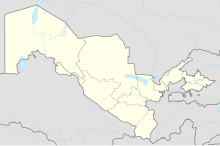Chalchayan
Coordinates: 38 ° 17 ′ 37 ″ N , 67 ° 58 ′ 44 ″ E
Chalchayan are the remains of an ancient city, located in the south of today's Uzbekistan on the Surxondaryo . The place was partially excavated from 1959 to 1963. Above all, the remains of a palace came to light, which was richly decorated with painted clay sculptures, which are among the most important sculptures in Central Asia.
The clay sculptures were all on the gallery, which led around the 17.5 × 6 meter main hall at a height of three meters. In the middle were the figures of a ruler and his court. Clay figures of gods adorned the wall above. Other figures, which were on the side walls, embody riders and stage the Dionysus cult.
Chalchayan was probably founded in the 2nd century BC. Founded by the Yuezhi . The palace probably dates to the 1st century AD and thus under the Kushana , who emerged from the Yuezhi. The figures found are particularly important because of their realism. Some of them probably represent rulers, so that it is also assumed that these were the remains of a temple for a ruler cult. There were also remains of wall paintings, but these were poorly preserved.
literature
- Boris J. Stawiskij: The people of Central Asia in the light of their art monuments , Bonn 1982, ISBN 3-921591-23-6 , pp. 87-92
Web links
Individual evidence
- ↑ Vadim M. Masson: The land of a thousand cities. Bactria - Khorezmia - Margiane - Parthia - Sogdia. Excavations in the southern Soviet Union. Udo Pfriemer, Wiesbaden / Berlin 1987, p. 92f

